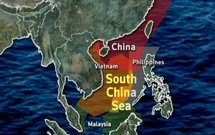 The South-China Sea dispute is axiomatic of the brewing great power rivalry between the US and China, raising serious questions about the viability of the US hub and spokes model governing East Asian relations.
The South-China Sea dispute is axiomatic of the brewing great power rivalry between the US and China, raising serious questions about the viability of the US hub and spokes model governing East Asian relations.
Notably, the hub and spokes liberal institutional order was created by the US in East Asia in the post-War era to not only contain the Soviet Communist expansionism but more importantly to tie down the spokes in the wheel: Japan, South Korea, Philippines, Thailand, Australia and Taiwan - in a tight bilateral-hegemonic system. More specifically, it was aimed at clipping the militarist Japan after its defeat and turning it into a pacifist nation while maintaining military base for US operations against the Communist bloc.
Logically, with the disappearance of the Soviet threat, the US hub and spokes security architecture should have fizzled away. But it did not. Instead in the post-Cold War era, the US reinvigorated its alliance with Japan and more recently it has rebalanced its interest in East Asia by its 'pivot' policy. America's reaching out to its erstwhile adversaries, Myanmar and Vietnam, is integral to this pivoting strategy. The US rebalancing has, in turn, led the Chinese to retaliate with its latest declaration of the Air Defence Identification Zone (ADIZ) in the East China Sea and posing threats of expanding it to the South China Seas. In fact, the ADIZ is a manifestation of China's incremental recreation of the Chinese-centered order which would not only challenge the hub and spokes system but more specifically test the US as a security guarantor of East Asia.
Indeed, the US is in a great dilemma. To remain credible, it needs to check the Chinese advance against its allies. However, buying Chinese enmity is not in the US interest, more so when its economy is deeply entwined with it. The US would ideally want a status quo where its allies do not scale up their territorial demands and China does not disturb regional peace. But the countries in the region, including China, Philippines and Vietnam, given their past histories of colonial domination, are extremely sensitive about sovereignty and hence not eager to give up nationalist claims.
The other option for the US would be to share power with the Chinese in managing the East Asian order as was evident in the G-2 formulation in 2009. But this would certainly reduce US credibility and propel Japan to militarise. Further, Shinzo Abe has hinted that economic interdependence is no guarantee for peaceful relations. In this scenario the region is 'ripe for rivalry'. There is also a lurking question in the East Asian region that if the US does not come to the aid of the allied partners, what is the option?
India while not being an actor in the dispute has got embroiled in the region by virtue of its Look East Policy. Therefore, it becomes imperative for India to manoeuvre a way out from the growing Chinese belligerence and emerging great-power rivalry reminiscent of the Cold War bipolar conflict. For India, instead of acting as a swing power in the US-China power rivalry akin to China in the strategic triangle of the 1970s and 80s or bandwagoning with either power, the best hedge strategy would be to create a multi-polar-third pole. This multi-polar-third pole would comprise, besides India, Vietnam, Philippines and Japan, and allow the pole to create a strategic space in the US-China 'bipolarism'.
The US needs to be kept away because first, its presence will invite Chinese suspicion and cause the eventual demise of the pole as was evident in the quadrilateral initiative in the post-Tsunami period. Second, the US' interest in the region more than to provide security to the allied partners is essentially to clip their powers, as evident in its ambiguous relations with Japan and Taiwan. It cannot be relied upon. Third, Indo-US collaboration in resisting the Chinese would turn the heat of the Sino-Pakistani nexus on India itself. Nevertheless, the US would not be obstructionist since the multi-polar-third pole would deter China and preserve US interests in the region by sharing the mantle of security with its allied partners and friendly countries.
Vietnam and Philippines should be members of the third pole as they are victims of Chinese bellicosity and hence have commonality of interests in resisting the Chinese despite similar territorial claims in the Spratly. Japan's presence is crucial as New Delhi has elevated its ties with Tokyo to the very centre of its Look East policy. More significantly, Shinzo Abe's foreign and domestic policy is gearing towards a 'normal' Japan by urging a revision of Article 9 of the Japanese Constitution that prohibits its military role. A normal Japan is in the interest of India not only to resist Chinese belligerence but also to consolidate its Look East Policy.
In sum, amidst the growing US-China great power rivalry, the creation of a multi-polar-third pole would allow India to retain its strategic autonomy and at the same time avoid being sucked into the US-China enmity. More significantly, the multi-polar-third pole, with Japan on board, would allow India to sustain pressure on the Chinese periphery and counter the Sino-Pakistani challenge on its Western periphery.
By Special Arrangement with Institute of Peace and Conflict Studies (http://www.ipcs.org)